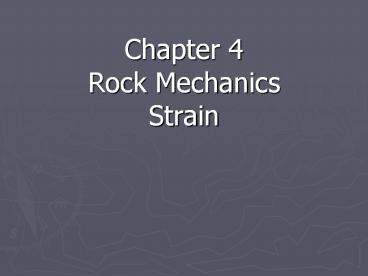Chapter 4 Rock Mechanics Strain - PowerPoint PPT Presentation
Title:
Chapter 4 Rock Mechanics Strain
Description:
Homogenous Strain - Lines that are straight and parallel before deformation ... so that angles between originally orthogonal reference lines are rotated. ? = tan ? ... – PowerPoint PPT presentation
Number of Views:869
Avg rating:3.0/5.0
Title: Chapter 4 Rock Mechanics Strain
1
Chapter 4Rock MechanicsStrain
2
Strain
- By comparing rocks in the deformed state to the
original undeformed state, we get a better
understanding of tectonic structures.
3
Definitions
- Deformation - The displacement field for
tectonically driven particle motions - Distortion - Involves a change in shape,
rotation, and translation. - Strain - Aspects of shape change measured in line
length, angular relationship between lines, or
volume.
4
Deformation
Strain
5
Definitions
- Homogenous Strain - Lines that are straight and
parallel before deformation remain straight and
parallel after deformation. - Inhomogenous Strain - The landscape is distorted
and lines may be broken.
6
Homogenous and Inhomogenous Strain
Homogenous Strain
Inhomogenous Strain
7
Definitions
- Incremental Strain - Describes the deformation
history of the rock body. - Usually cannot differentiate the deformation
history. - Finite Strain - A comparison can be made between
the present shape and some previous shape. - Finite strain is path independent.
8
Measures of Strain
- Strain may be recognized as a change in line
length, angles between lines, or volume.
9
Linear Strain
- Elongation - The ratio of the length of the line
in the deformed mass (l1) minus the length of the
original line (l0). e (l1 - l0)/l0 ?l/l
10
Linear Strain
- Stretch - also called engineers stretch - is
simply the length of the deformed line divided by
the original length. S l1/l l e
11
Linear Strain
- Quadratic Elongation - The square of the
stretch. ? (l1/10)2 (1 e)2 S2
12
Linear Strain
Elongation?
e (l1 - l0)/l0 (5-3)/3 0.67
Stretch?
S l1/l 5/3 1.67
Quadratic elongation?
? (l1/10)2 (5/3)2 2.78
13
Shear Strain
- Shear Strain (?) - Strain that results when parts
of a rock body are deformed so that angles
between originally orthogonal reference lines are
rotated. ? tan ?
14
Dilation Strain
- Dilation Strain (?) - Changes in volume
- Three possible mechanisms
- Closing voids - Negative volume change
- Dissolving by pressure solution - Negative volume
change - Fracturing the mass - Positive volume change
- ? (V1 - V0)/V0 dV/V0
15
Dilation Strain
16
Strain Ellipsoid
- Strain Ellipsoid - Graphical tool that provides a
reference object for estimating shape change from
an assumed initial sphere. - Elliptical sections through these are sometimes
printed on geologic maps to indicate geologic
strain. - Made of three mutually perpendicular axes x, y,
and z, where X ? Y ? Z.
The Strain Ellipsoid usually has an inverse
relationship with the Stress Ellipsoid. X
corresponds to s3.
17
Shear
- Simple Shear - Rotational homogenous shear with
motion between layers. - Pure Shear - Distortion by homogenous deformation
without rotation.
18
Strain Measurements
- Strain Markers - A deformed feature in the rock
that can be measured to determine strain. - Have to know the original shape for comparison.
- Should have the same mechanical characteristics
as the original rock.
19
Strain Markers
- Good strain markers include
- Reduction Spots
- Pebbles
- Ooids
- Fossils
- Vesicles
- Pillow Basalts
- Burrows
20
Flinn Diagram
- Flinn Diagram - Most useful means of displaying
constant-volume finite strain. - Invented by the British structural geologist
Derek Flinn in 1962.k (Rxy-1)/(Ryz-1)Rxy
(1e1)/(1 e2)Ryz (1e2)/(1 e3)
21
Wellmans Method
- Wellmans Method - A simple geometric technique
for determining the orientation and shape of the
strain ellipse. - Requires at least ten strain markers.
- All must be on the same plane.
- Most commonly use brachiopods or trilobites.
22
R Method































